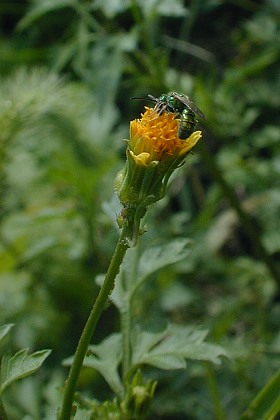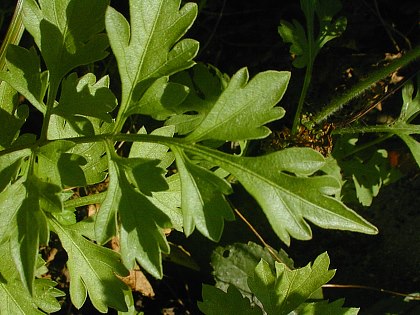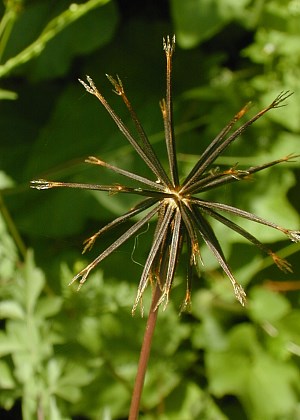 Description:
This plant
is a summer annual about 2-5' tall; it is more or less erect and
branches occasionally. The stems are green or reddish green, angular,
strongly veined, and hairless (or nearly so). The leaves are mostly
opposite; their blades are up to 8" long and 4" across, while their
petioles are up to 2" long. The leaf blades are double- or
triple-pinnate, medium green, and hairless (or nearly so). The segments
of the blades are ovate, lanceolate, or oblanceolate with blunt tips
and wedge-shaped bottoms; the margins of these segments are irregularly
cleft or dentate. Overall, the leaf blades have a fern-like appearance.
The upper stems terminate in individual flowerheads on long peduncles.
Each flowerhead is about ½" long and ¼" across; it has numerous disk
florets in the center and 0-5 ray florets along its upper margin. The
disk florets have corollas that are golden yellow and tubular in shape;
each corolla has 5 tiny lobes along its upper rim. The yellow ray
florets are petal-like; they are about 1/8" (3 mm.) long and oval to
oblong in
shape. Some flowerheads may lack petal-like extensions of the ray
florets altogether. The base of the flowerhead is surrounded by green
bracts; the linear inner bracts are much longer (about 1/3" or 8 mm. in
length)
than the outer bracts. The blooming period occurs during the late
summer or early fall. Each flowerhead is replaced by a seedhead that is
globoid in shape and spans about 1" across. The long narrow seeds
(achenes) spread outward from the center in all directions. Each mature
seed is linear in shape, 4-angled, and dark brown; it has 2-4 short
awns at its tip. Each tiny awn has downward-pointed barbs. The root
system consists of a branching taproot. This plant spreads by reseeding
itself.
Description:
This plant
is a summer annual about 2-5' tall; it is more or less erect and
branches occasionally. The stems are green or reddish green, angular,
strongly veined, and hairless (or nearly so). The leaves are mostly
opposite; their blades are up to 8" long and 4" across, while their
petioles are up to 2" long. The leaf blades are double- or
triple-pinnate, medium green, and hairless (or nearly so). The segments
of the blades are ovate, lanceolate, or oblanceolate with blunt tips
and wedge-shaped bottoms; the margins of these segments are irregularly
cleft or dentate. Overall, the leaf blades have a fern-like appearance.
The upper stems terminate in individual flowerheads on long peduncles.
Each flowerhead is about ½" long and ¼" across; it has numerous disk
florets in the center and 0-5 ray florets along its upper margin. The
disk florets have corollas that are golden yellow and tubular in shape;
each corolla has 5 tiny lobes along its upper rim. The yellow ray
florets are petal-like; they are about 1/8" (3 mm.) long and oval to
oblong in
shape. Some flowerheads may lack petal-like extensions of the ray
florets altogether. The base of the flowerhead is surrounded by green
bracts; the linear inner bracts are much longer (about 1/3" or 8 mm. in
length)
than the outer bracts. The blooming period occurs during the late
summer or early fall. Each flowerhead is replaced by a seedhead that is
globoid in shape and spans about 1" across. The long narrow seeds
(achenes) spread outward from the center in all directions. Each mature
seed is linear in shape, 4-angled, and dark brown; it has 2-4 short
awns at its tip. Each tiny awn has downward-pointed barbs. The root
system consists of a branching taproot. This plant spreads by reseeding
itself.
Cultivation:
Partial or dappled sunlight, moist to mesic conditions, and a fertile
loamy soil are preferred. However, this robust plant can adapt to a
wide range of environmental conditions. The size of individual plants
varies significantly, depending on moisture levels and soil fertility.
Range & Habitat:
The native Spanish Needles is occasional to locally common in southern
and central
Illinois; it is mostly absent in the northern section of the state (see
Distribution
Map). Habitats include open woodlands, woodland borders,
savannas, thickets, rocky glades, riverbanks, weedy meadows, vacant
lots, partially shaded areas along buildings, areas along railroads and
roadsides, abandoned fields, and waste areas. Habitats with a history
of disturbance are preferred. In Illinois, Spanish Needles is more
often found in drier habitats than other species in the genus.

Faunal Associations: The nectar and pollen of the flowerheads attract bees: these include honeybees, leaf-cutting bees (Megachile spp., Coelioxys sayi, & Heriades leavitti), and Halictid bees (including green metallic bees). Other insect visitors of the flowers include Syrphid flies and the butterfly Pieris rapae (Cabbage White). Rather then visiting the flowers, other insects feed on the foliage and other parts of Bidens spp. These species include the caterpillars of the moths Cirrhophanus triangulifer (Goldenrod Stowaway), Condica confederata (The Confederate), Epiblema otiosana (Bidens Borer Moth), Palthis asopialis (Fainted-Spotted Palthis), Platysenta mobilis (Mobile Groundling), and Synchlora aerata (Wavy-Lined Emerald). The leaf beetles Calligrapha bidenticola and Calligrapha californica feed on the leaves of Bidens spp., while the aphid Aphis coreopsidis sucks juices from the flowering stalks. Many of these insects feed on similar plants in the Aster family. Seeds of Bidens spp. are eaten to a minor extent by various birds, including the Ring-Necked Pheasant, Bobwhite, Wood Duck, Purple Finch, and Common Redpoll. The foliage is sometimes eaten by the Cottontail Rabbit. The barbed awns of the seeds can cling to the fur of passing animals and the clothing of humans; in this manner, the seeds are distributed far and wide.

Photographic
Location:
The photographs were taken at a small grove of trees along a railroad
in Champaign, Illinois, and a vacant lot in Urbana, Illinois. In one
photograph, a green metallic bee is visiting a flowerhead. Underneath
this flowerhead, there are some greenish aphids sucking juices from the
stalk, although they are difficult to see.
Comments:
The arrangement of the trident-shaped seeds into globoid seedheads is
very striking. The common name derives from the appearance of these
seeds. Among the many Bidens spp. in Illinois,
Spanish Needles is the oddball of the group. The seeds of Spanish
Needles are longer and usually more slender than those of other Bidens
spp. Spanish Needles also has differently shaped leaves –
they are more pinnately divided into smaller leaf segments than the
leaves of other Bidens spp. (which are sometimes
simple, rather than compound). Finally, Spanish Needles seems to prefer
drier habitats; other Bidens spp. are more likely
to be found in various wetland habitats.